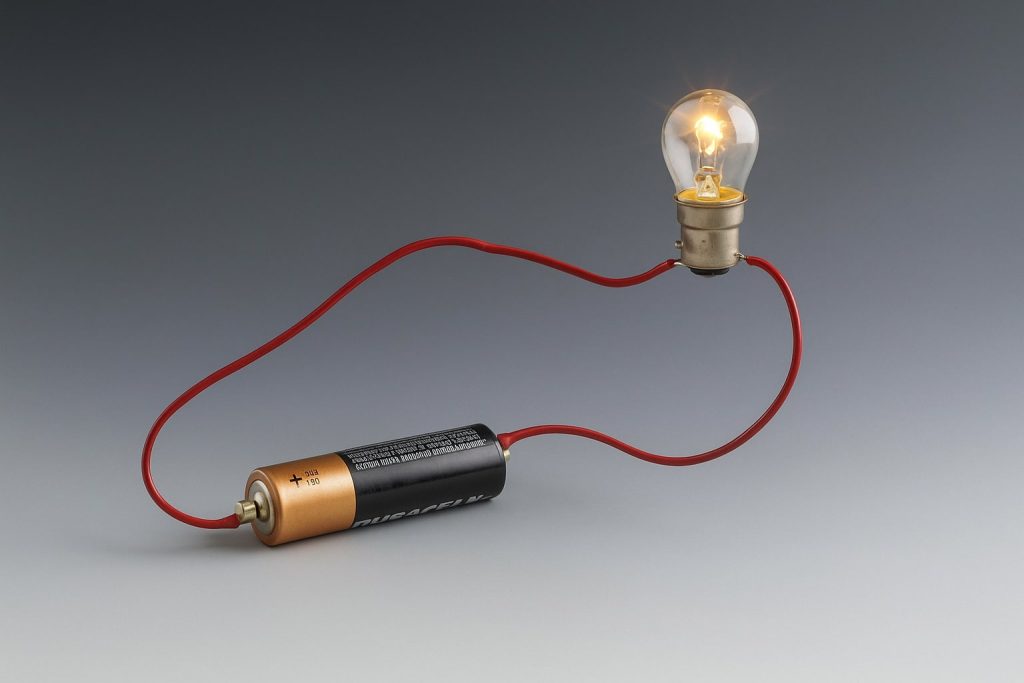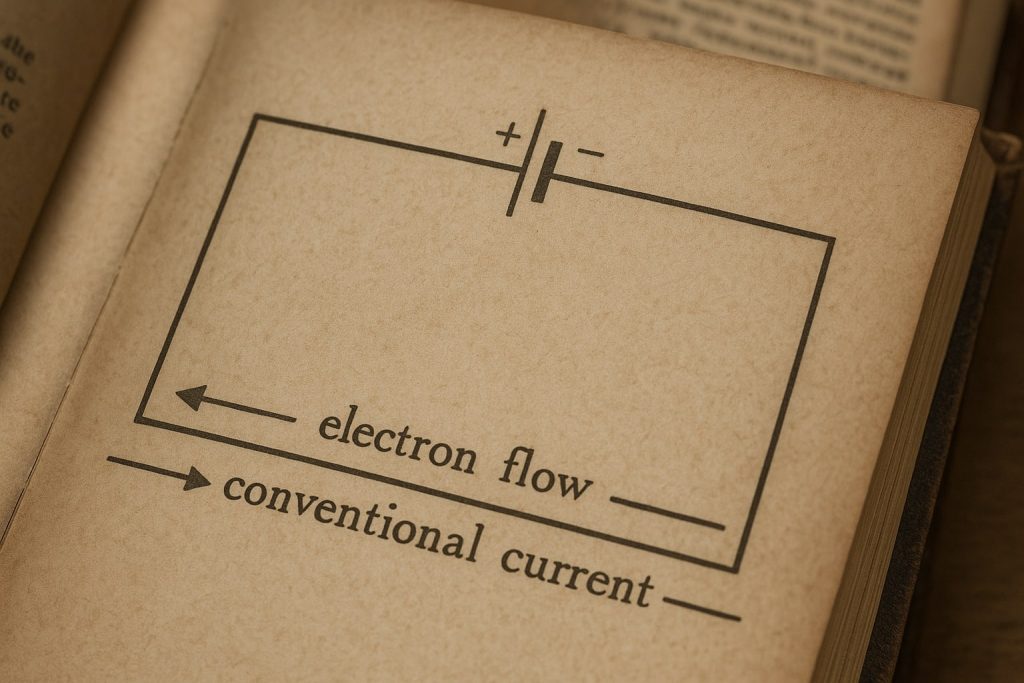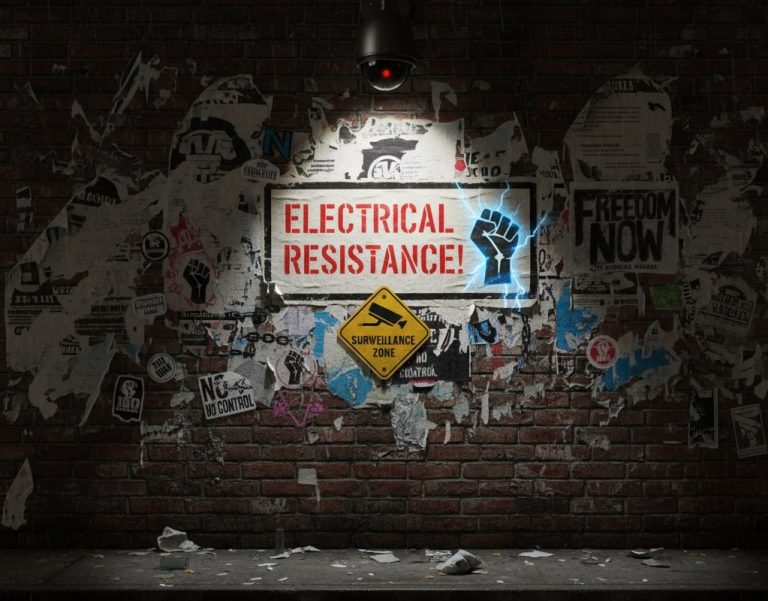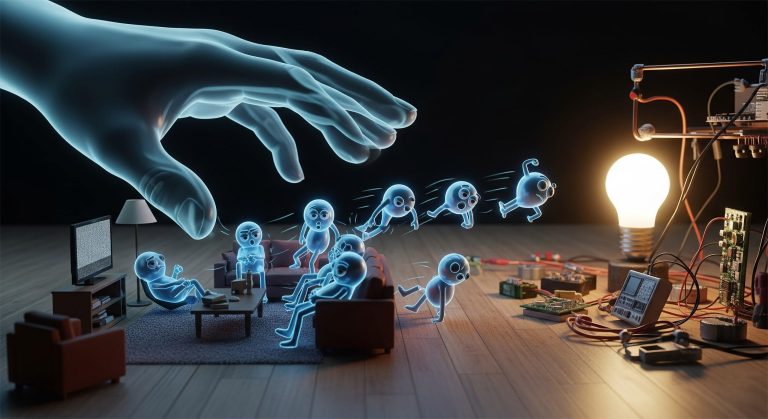Let’s face it—we live in the age of electricity. It’s everywhere. Your screen? Powered. Your phone? Powered. Your lights, music, laptop, fridge, microwave, treadmill (that you totally don’t use), and yes—your sacred, holy, life-giving coffee machine?
All running on electricity.
Electricity: powering your caffeine addiction since the 1800s. ☕⚡
Now, if I ask, “How does all this work?” you might say:
“Well, wires run from power plants to my home, and voilà—electricity!”
Great! True! But let’s go deeper. What are you actually getting from those wires?
Is it a liquid? A powder? Tiny gremlins on treadmills? Is Zeus personally zapping electrons down the line?
When I fill my gas tank, I see the fuel. Smell it. Pay too much for it. But when I plug in my phone? Nothing. Just… charging. Something invisible is happening in that cable. But what?
What even is electric current?
If your brain just shrugs and says, “It’s just electricity, dude,” don’t worry—you’re not alone. Most of us treat electricity like WiFi or taxes: we don’t get how it works, but we accept it as part of modern life.
Electric current is that mysterious something we all use but almost no one can explain at a party. 🎉🔌
Well, today that changes.
We’re diving into what electric current really is, how it moves (hint: not as fast as you think), and why it’s the unsung hero of everything from your morning toast to your late-night scrolling.
No dry textbook talk. Just strange metaphors, simple truths, and probably a joke about electrons.
Welcome to 1000whats—your backstage pass to the weird, wonderful world of energy. Let’s flip the switch and figure out what’s really flowing through those wires. 💡⚡
Ready? Let’s zap into it.
What is electric current?
Let’s break it down like this: current is just stuff moving.
Water down a stream? Current. Air sweeping across your face on a windy day? Also current. Basically, whenever something flows from one place to another over time, you’ve got yourself a current.
Now swap out the water for electric charge, and the stream for a wire, and you’ve got electric current. Simple, right?
Electric current is the rate at which electric charge flows through a material.
In most cases—like the wires in your phone charger—this charge is carried by tiny, jittery electrons.
These little guys don’t zoom like racecars. Instead, they shuffle along slowly like tourists at a museum. Yet somehow, when you flip a switch, the lights turn on instantly. Magic? Not quite.
Marbles, not magic
Picture this: a long plastic tube filled with marbles. You give the first marble a nudge, and the last one pops out almost immediately. No marble teleports. They just push each other along, one after the other.

That’s your current. The marbles = electric charges. The nudge = voltage. The tube = wire. The action? Smooth, coordinated motion.
Electric charge is quantized—it moves in chunks, not a steady liquid.
In metals like copper, it’s electrons doing the work. In batteries or salty water, it’s ions—both positive and negative—joining the party.
So, don’t get stuck thinking it’s all about electrons. It’s about charge movement, no matter who’s carrying it.
And remember: the electric field travels fast, almost instantly triggering movement across the entire circuit—even though the charges themselves are taking their sweet time.
Electric current is a team effort—it’s not about speed, it’s about cooperation. ⚙️
Why do charges flow?
Let’s roll up our sleeves and get curious. Why does electric current even happen? The story starts with the smallest characters in physics—electric charges.
Every electron carries a negative charge, while every proton carries a positive one. When they exist in equal numbers inside an atom, they cancel each other out. The result? A neutral atom, chilling in equilibrium.
Electric charge is a basic property of matter—like mass, but with a magnetic personality.
If you’re eager to dive deeper, I recommend checking out the full article on electric charge here: Electric charge @ 1000whats
The secret life of a copper wire
Imagine a copper wire just lying on your desk.
It looks peaceful, harmless even. But underneath that quiet exterior, it’s full of atoms surrounded by electrons. Some of those electrons—especially the ones in the outer shell—aren’t very loyal. They wander. In metals, these so-called “conduction electrons” are free to roam around the structure like toddlers in a candy shop.
So, what makes them actually move?
Think back to our marble analogy. Marbles don’t just start rolling for fun—they move because we tilted the tube. That tilt created a difference in height, and gravity pulled the marbles downhill.
In electricity, we don’t use gravity—we use voltage, which creates an electric field to nudge charges along. ⚡
Voltage: The great motivator
When you connect a wire to a battery, something magical happens. The battery creates a difference in electric potential—voltage. That’s your “tilted tube.”
Now, electrons feel a force. They start drifting through the wire, slowly but surely, from the negative terminal toward the positive one.
Why? Because electrons have a negative charge, and voltage creates an electric field that pushes them away from negative and toward positive.
Electric current is the flow of electrons under the push of an electric field, created by voltage.
And just like marbles bumping into each other, electrons collide with atoms as they move. These collisions don’t stop them, but they do slow them down and generate heat—this is resistance.
Resistance turns some of the electrons’ energy into heat, just like friction heats your hands when you rub them. 🔥
So, in short: charges flow because voltage tells them to. It’s all about pushing electrons out of their comfy orbit, getting them to bump through a metal maze, and lighting up your world in the process.
Do electrons really make up the electric current?
“Hold up,” your brain yells. “You said charges move. Then you said electrons move. What’s actually moving here?!”
If you’re confused, you’re in great company. This question stumps nearly every first-timer—and even a few physics majors during finals.
Electric current is the flow of electric charge—but what carries that charge depends on the material. ⚡
Who’s carrying the load?
Let’s clear the fog: charge is a property, like mass or color. You don’t put charge on a particle—it is the particle.
Electrons? Always negative.
Protons? Always positive.
Neither borrows charge like a coat. They are the coat.
So when an electron moves through a metal wire, it takes its charge with it. That movement is what we call electric current in metals. And since 99% of the circuits around you use metal, it’s usually electrons doing the heavy lifting.
In metals, current is the slow, steady drift of electrons and their built-in negative charge. 🐌
🧠 A Staircase, a body, and a packet of charge
Here’s a goofy analogy that works: I weigh 84 kilos. If I walk up the stairs, my weight goes with me. I don’t leave it on the couch. It’s not something I carry—it’s what I am.
Same thing with electrons. When they move, their charge isn’t packed in a suitcase—it comes with them. So yes, in most wires, electric current is electrons moving. That’s not the whole story everywhere, but it’s the everyday reality in your phone, your lamp, and your toaster.
Electrons don’t carry charge. They are the charge. 🔋
So next time someone says, “Current is just the flow of electrons,” you can nod—knowing that it’s both true and, delightfully, just the beginning of the story.
How fast is electric current?
“Wait, what? Did you just say current is slow? But lightning is fast! My light turns on instantly!”
Yep, I hear you. It sounds like physics is pulling a fast one. But stick with me—we’re about to untangle this paradox with marbles, ants, and a sprinkle of light-speed magic.
Electric current is the effect that moves fast—not the particles themselves. ✨
Marbles in a tube (Yep, we’re back here again)
Picture a clear tube packed end to end with marbles. Push one in on the left, and—boom!—one pops out the right side instantly. Pretty slick, right?
But here’s the trick: none of the marbles zoomed across the tube. Each marble just nudged the next. The push moved fast. The marbles? Barely shifted.
Fast push, slow marbles. Movement spreads instantly—but the marbles themselves take their sweet time.
This is the perfect metaphor for what happens in a wire.
Enter: Real electrons
Your copper wire is already packed with electrons, just like our marble tube. Flip a switch, and a sudden electric field forms inside the wire. It zips through the metal almost as fast as light.
That field is the “push.” It doesn’t move the electrons from end to end. Instead, it tells all the electrons, everywhere, to start drifting.
The electric field travels fast—the electrons it pushes move painfully slow. 🐌
We’re talking millimeters per second. Like snails on vacation. Why? Because electrons keep crashing into atoms, zigzagging like they’ve had too much coffee.
But here’s the kicker: because the electric field reaches every part of the wire almost instantly, electrons everywhere start to move at once. That’s why your lamp turns on right away—even though no single electron sprinted from the battery to the bulb.
It’s not about speed—it’s about synchronization.
Final answer:
Electric current is fast like lightning in how quickly it starts — but the tiny particles that make it up move slowly, just enough to keep the current going.
Electricity is sneaky like that. 😉
How does electric current work?

Let’s imagine this:
- You have a battery (with a + and − terminal),
- A copper wire connected from one end of the battery to the other,
- And the wire is just lying there, full of electrons (which it always is — copper atoms have free electrons roaming around).
Now… you connect the battery and ask:
“What exactly happens?”
1️⃣ Step 1: The wire is already full of electrons
Before you even flip the switch or connect the battery:
- The copper wire already has tons of free electrons — just sitting there, bouncing around randomly.
- They’re not moving in any particular direction yet — it’s like a chaotic dance party.
So the wire is like a long tunnel already packed with marbles (electrons) — but the marbles aren’t going anywhere, just wiggling around.
2️⃣ Step 2: You connect the battery → the electric field is created
As soon as you connect the battery:
- The battery creates a difference in electric potential between its terminals.
- That creates an electric field inside the wire — think of it like an invisible force that points from the positive end to the negative end (even though electrons will move the opposite way 💡).
Now, here’s the key:
🧠 What does it mean that “the electric field moves instantly”?
It doesn’t mean something travels through the wire at infinite speed.
It means that the force on the electrons is established nearly instantly throughout the wire — at about half to almost the full speed of light, depending on the material.
❗ Why?
Because when you hook up the battery, the electric field spreads through the conductor kind of like a ripple — and the electrons inside the wire immediately feel the push.
So now, every free electron in the wire senses the same thing at almost the same time:
“Hey, there’s a force — I need to move!”
3️⃣ Step 3: The electrons start to drift
Now that they feel the field, the electrons:
- Don’t zoom forward,
- But start drifting slowly — like ants being gently pushed down a narrow tunnel.
They move slowly because:
- They bump into atoms,
- They zigzag,
- And they keep getting scattered — but still drift in the direction opposite the electric field.
This slow average movement is called drift velocity, and it’s super slow (maybe a millimeter per second).
4️⃣ Step 4: So how does the lamp turn on immediately?
Let’s go back to our marble tube analogy:
- If you push one marble in at one end,
- Another marble immediately pops out the other end — because all the marbles are already in place.
So even though each marble barely moves, the push travels through the entire line instantly.
Same with the electrons:
- The battery doesn’t have to send electrons all the way to the lightbulb.
- It just nudges the electrons in the wire, and that nudge spreads quickly through the whole circuit.
- So, electrons everywhere start drifting at the same time, and the bulb lights up instantly.
✅ Final summary (bit by bit):
| Step | What happens |
| 1. Before battery | Wire is full of free electrons moving randomly |
| 2. Battery connected | An electric field is established almost instantly |
| 3. What field does | Pushes on all electrons at once throughout the wire |
| 4. Electrons respond | They start to drift very slowly |
| 5. Result | Current starts flowing; devices react immediately |
💡 Simple metaphor
Think of people standing in a packed hallway. When the person at the end starts to push, no one needs to run — everyone just leans forward slightly, and that little movement gets passed down instantly. That’s current.
What is the direction of the current?
Here’s where things get deliciously weird.
Electrons are negatively charged. They move toward the positive terminal in a circuit. So logic screams: “Hey! That must be the direction of current!”
But then, you open a textbook—or peek at a circuit diagram—and what do you see?
The current flows from the positive terminal to the negative one. Huh?
Electrons go one way. But current is drawn flowing the other. Welcome to the great electric paradox. ⚡
A little historical misfire
Blame it on history. Way back—before electrons were even discovered—scientists guessed that current must involve positive stuff flowing from the positive terminal.
That guess stuck. And when J.J. Thomson discovered the electron in 1897, we realized: “Oops. It’s actually negative charges doing the moving.”
But by then, all the diagrams, equations, and engineering standards were already built on the other assumption. Rather than rewrite all of physics, scientists shrugged and said, “Let’s just keep it that way.”
“Conventional current flows from positive to negative—even though the actual electrons go the other way.” 🔁

Where do we still use conventional current?
Despite being “technically backward,” conventional current flow is still king in several places:
- Circuit diagrams: Always show current flowing from + to −. It standardizes design and makes communication easier.
- Engineering equations: Ohm’s Law, Kirchhoff’s Rules, and other laws are all based on this direction.
- Textbooks: To avoid total chaos, nearly all learning materials use conventional current.
- International standards: Uniformity is key—so the old convention stays.
- Simulation tools: Software like SPICE also follows the traditional flow direction to match the math.
It’s not wrong—it’s just conventional. Like driving on the left side of the road in some countries. 🚗
How is electric current measured?
To measure electric current, we don’t just guess or eyeball it—we use a precise unit: the ampere (A), often just called an amp. And yes, it has a rich backstory.
One ampere equals one coulomb of charge passing a point every second. ⚖️
The ampere is named after André-Marie Ampère, a brilliant 19th-century scientist who helped unlock the secrets of electromagnetism. In the world of physics, he’s kind of a big deal.
💡 So… what’s a coulomb?
Here’s the key bit: one coulomb equals roughly 6.242 × 10¹⁸ electrons. So when your phone charger says it’s pushing 2 amps, that means over 12 quintillion electrons are flowing through the cable every second.
1 A = 6.242 × 10¹⁸ electrons per second. That’s a lot of little movers. ⚡
The tools: Ammeter & friends
To actually measure that current, we use an ammeter. This device has a superpower—it measures how much charge is flowing through it per second.
But here’s the trick: the ammeter has to be in the path of the current. So we connect it in series, meaning it becomes part of the circuit. That way, every electron passing through the circuit also passes through the ammeter.
Ammeters are installed in series—because they need to count all the passing charge. 🧮
For tiny currents, use a galvanometer
When current is too small to show up clearly on a standard ammeter—think microamperes (µA)—we use a more sensitive tool: the galvanometer. It’s like an ammeter, but with a microscope and a magnifying glass taped on.
Alright, not literally—but you get the idea.
Measuring current is all about counting how much electric charge flows per second. Whether it’s a thundering amp or a whisper of microamps, we’ve got the tools to catch it.
What is the use of electric current?
This might sound like a “duh” question—but really, why do we care so much about electric current?
Why build giant power plants, string up miles of cable, or invent gadgets to measure it?
Because electric current is how we move energy.
Electric current is the delivery truck for electrical energy. 🚚
From wind to wire: The energy transfer game
Let’s take a wind turbine as our example.
Wind spins the turbine blades. The blades turn a rotor. Inside that rotor? Coils of wire spinning in a magnetic field. That spinning motion creates a changing magnetic field—which, according to Faraday’s Law, induces electric current in the coils.
Spinning coils inside a magnet = electric current, thanks to Faraday. 🧲
Now, faster winds mean faster spinning. That means more voltage, which leads to more current. And more current? More energy sent zipping down power lines to homes, factories, or that weird lamp on your desk.
In short:
Electric current is the carrier of electrical energy.
It doesn’t create energy, but it’s the essential movement that lets energy travel from a source (like a battery or turbine) to where it’s needed — to light up your room, charge your phone, or run a factory.
Final thoughts
Electric current isn’t just a concept—it’s the quiet force powering nearly every corner of modern life. From charging your phone to running cities, it’s everywhere.
At its core, it’s simple: a flow of electric charge, driven by voltage, coursing through a conductor. Often it’s electrons doing the moving, creating a current that becomes useful energy.
Electric current is the movement that makes modern life move. 🔌
Looking ahead: The future is electric
As we shift to cleaner energy, smarter transportation, and life-saving medical tech, electric current becomes more important than ever.
Renewable energy systems depend on efficient current control. Electric vehicles live and die by current management. Even artificial hearts and neurotech run on finely tuned currents.
Mastering current is key to building a sustainable, electrified future. 🚗🌞
Questions to spark thought
Let’s leave with a few sparks of curiosity:
- How does our hunger for electric power shape the environment?
- What new materials could make electric systems safer and more efficient?
- What breakthroughs lie ahead in current-based tech?
- And how can we make sure everyone understands how to use electricity safely?
Stay curious, stay safe
Understanding electric current empowers you—not just to use devices, but to innovate, explore, and build smarter solutions.
So share your ideas, your questions, your “aha!” moments. Join the conversation, and don’t forget to follow the 1000whats blog for more electrifying insights.
“Electricity isn’t just power. It’s potential.” 💡Until next time—stay curious, stay grounded, and never stop asking why.




[…] instead of a splash, you get a stream of electrons zipping out. That flow of electrons? That’s electric current. And what caused it to move in the first […]
[…] if you’re wondering how this all works, I already spilled the beans over here: Electric Current — 1000whats. That post dives into how electrons march, stumble, and occasionally party their way through […]